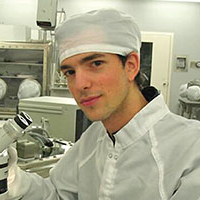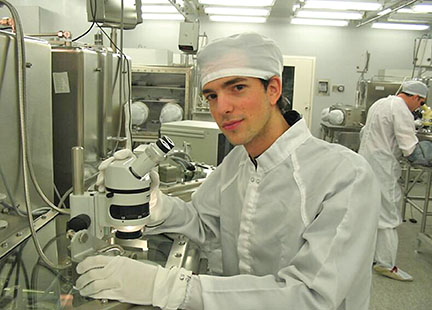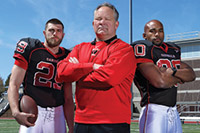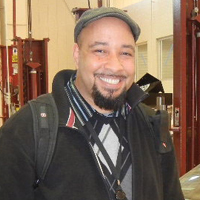IAN GARRICK-BETHELL ’02 TAKES A MOON SHOT


Ian Garrick-Bethell ’02 wants to get you pumped about the moon. One way he might do this is to send a small piece of you up there.
Garrick-Bethell, a professor of planetary sciences at the University of California, Santa Cruz, and colleagues are inviting members of the public to submit a single hair, along with a small cash donation, in order to help them raise money to develop a “Mooncube” that would go on a craft taking part in Google’s Lunar X Prize contest. The contest promises $30 million to the first private company that lands on the moon. Though the crowd-funded project could help catalyze innovations in aeronautics, Garrick-Bethell sees it mostly as a way to get students and others excited about our nearest celestial neighbor. “It’s a way to let everyone be interested,” he says. “You could look up at night and say, ‘Hey, there’s a piece of me on the moon there.’ For 30 bucks!”
The project is still in its early stages and the details may change, Garrick Bethell says. But combining science and public engagement has long been one of his goals. At UC Santa Cruz, he spends his days cooking up ways to pull new data from the old moon. One of his projects involves flinging tiny probes called CubeSats, roughly the size and shape of a loaf of bread, directly at the lunar sphere. The probes, which Garrick-Bethell thinks could be launched in the next few years, would send back measurements of the moon’s surface magnetism up until milliseconds before impact.
This kind of innovative thinking has made Garrick-Bethell a rising star in his field, says fellow UC Santa Cruz planetary scientist Francis Nimmo. “[Ian] is very creative, and so he can think about problems that people have been thinking about for hundreds of years and still manage to come up with a new idea.”
Indeed, Garrick-Bethell was already full of out-of-the-box ideas by the time he arrived at Wesleyan more than a decade ago. In addition to taking the standard physics lectures and labs, he led the university’s Society of Physics Students chapter for two years, spearheading a blimp launch, a trip to a decommissioned nuclear power plant, and physics shows for local high school students. “Wesleyan supported all my crazy ideas,” he says.
Garrick-Bethell also pursued opportunities far beyond campus, leading a team of fellow undergraduates who designed a fire extinguisher for possible use on the International Space Station. Their project earned them a trip to Houston and a ride on NASA’s KC-135A aircraft, popularly known as the Vomit Comet, where the group tested their extinguisher under zero-gravity conditions. While the project didn’t lead to any real-world applications, Garrick-Bethell says it did teach him valuable teamwork and project management skills.
“He was quite a mover, and outstandingly so because the stuff he organized has never been repeated,” recalls Reinhold Blümel, a Wesleyan physics professor and Garrick-Bethell’s undergraduate adviser. When not organizing fellow physics students and faculty, Garrick-Bethell worked with Blümel to understand how electrically charged particles behave in an electromagnetic trap consisting of a current-carrying wire. The collaboration led to three peer-reviewed publications, a thesis with high honors, and a prize for “a particularly resourceful and creative approach to physics research.” The experience “was really valuable,” says Garrick-Bethell. “I got to learn some computing skills and see how research was done.”
After graduation, Garrick-Bethell headed to MIT for a master’s degree in the university’s engineering-oriented Department of Aeronautics and Astronautics. But research was never far from his mind, and in his spare time he downloaded a data set from a recent NASA moon mission. He soon realized that lunar science was full of unanswered questions and hoping to answer some of them, he migrated to the lab of Maria Zuber, a prominent scientist in MIT’s Department of Earth, Atmospheric and Planetary Sciences. Within two years, Garrick-Bethell, Zuber, and a third colleague published a provocative paper in the prestigious journal Science, proposing that the moon once had a much closer and more elliptical orbit around Earth, spinning three times for every two revolutions, and that strong tidal forces at that time created a bulge that became “frozen” into the moon’s shape. Explaining the moon’s orbit and shape had vexed scientists since Isaac Newton, and a commentator in Science called the new idea “ingenious.”
Zuber says Garrick-Bethell has continued working at that level ever since. “The first time it happens you say, ‘Is this like a band with a one-album wonder?’ But for Ian the hits just keep on coming,” she says. “He was probably the best graduate student studying the moon in a decade.”
Another of Garrick-Bethell’s hits came from a mystery dating to the Apollo days: why many of the moon rocks astronauts brought back are magnetized, even though the moon has no magnetic field. Just getting to study one of these samples for the first time was a thrill, Garrick-Bethell recalls. “My adviser and I were terrified. We didn’t want to go near it because it was so precious. It was really exciting.”
Using radioactive isotope analysis, Garrick-Bethell and his colleagues determined that their precious rock was 4.2 billion years old, more ancient than all but the oldest known objects on Earth. The way the rock was magnetized suggested that the moon may have once had a magnetic field similar to Earth’s, which arises from electrical currents inside a swirling liquid metal core. The team published their results in 2009 in Science.
In 2010 Garrick-Bethell again made waves with an explanation for another puzzling observation from the Apollo program: The moon’s crust is several kilometers thinner at the poles than at other places. Garrick-Bethell and colleagues proposed an explanation, again published in Science, that billions of years ago when the moon was closer to Earth, powerful tidal forces squeezed and stretched the lunar crust. These distortions would have heated the crust at the poles and caused it to become thinner. Another group at UC Santa Cruz recently proposed an alternative hypothesis: that the varying crustal thickness resulted partly from an ancient object colliding with the moon. Garrick-Bethell, who says the two teams have a friendly rivalry, has a followup paper coming out this year that he thinks will end the debate.
Garrick-Bethell took the position at UC Santa Cruz in 2010. He continues to probe moon rocks’ magnetic properties in his lab, which are encased in a special kind of steel that protects the rocks from Earth’s magnetic field. Ultimately he hopes to bolster his lunar magnetism theory by having CubeSats measure the magnetic fields of rocks on the moon’s surface. He thinks one of these crafts could provide valuable data for around the cost of a luxury home—a price he hopes will be attractive to cash-strapped funding agencies. He and some colleagues have written a concept paper and are preparing to pitch their idea to NASA. Garrick-Bethell also has a visiting professorship at Kyung Hee University in South Korea and is collaborating with the Korea Aerospace Research Institute to potentially launch a fleet of moon-measuring CubeSats within the next decade.
So why spend so much time studying the moon when we’re here on Earth? To Garrick-Bethell, it’s only natural to want to understand an object that’s less than a hundredth the distance from us compared to any other. But his work is relevant not just for moon junkies, he says. “A lot of things you learn about the moon can apply to other solar system bodies. It’s a really nice laboratory.”
And, he reminds me, one of those bodies is our home. Since the solar system’s tumultuous infancy, when the moon formed out of debris from Earth’s collision with another planet, the two objects’ fates have diverged. Earth’s surface has remained violently and dynamically alive, and billions of years of erosion and plate tectonics have wiped out nearly all records of ancient impacts and convulsions. The moon too may have once pulsed with electric currents and magma flows, but all that motion froze out long ago, and no wind or water stirs its rocky surface. As a result, says Garrick-Bethell, we can look to the stoic moon for clues about our own planet’s early history. “It’s trying to understand our sister planet,” he says; “trying to understand how it was once like us.”
Gabriel Popkin ’03 is a science and environmental writer based in Mount Rainier, Md. He has written for Science News, Inside Science, and Johns Hopkins Magazine. He earned his bachelor’s in physics at Wesleyan. See more of his writing at gabrielpopkin.com.



